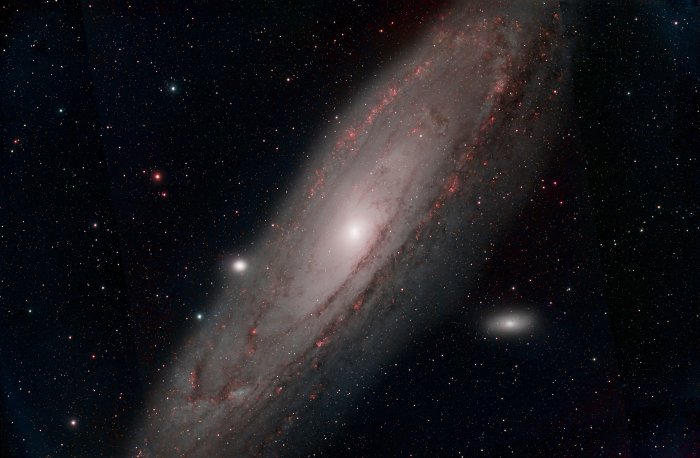ScienceDownEast | ScienceDownEast Astrophotography | Galaxies | M031 Andromeda Galaxy | M31 Andromeda Galaxy - re-processed with additional data
Note: click on the image to view it at the full resolution of the uploaded image, then click again for actual size.
The Andromeda Galaxy is a barred spiral galaxy and is the nearest major galaxy to the Milky Way and is cataloged as Messier 31. Andromeda has a diameter of about 152,000 light-years and is approximately 2.5 million light-years from Earth. The galaxy's name stems from the area of Earth's sky in which it appears, the constellation of Andromeda, which itself is named after the princess who was the wife of Perseus in Greek mythology The virial mass of the Andromeda Galaxy is of the same order of magnitude as that of the Milky Way, at 1 trillion solar masses (2.0×1042 kilograms). The Milky Way and Andromeda galaxies are expected to collide with each other in around 4–5 billion years, merging to potentially form a giant elliptical galaxy or a large lenticular galaxy. With an apparent magnitude of 3.4, the Andromeda Galaxy is among the brightest of the Messier objects, and is visible to the naked eye from Earth on moonless nights. Around the year 964 CE, the Persian astronomer Abd al-Rahman al-Sufi described the Andromeda Galaxy in his Book of Fixed Stars as a "nebulous smear" or "small cloud.”
| Exposure | 11x1200 sec + 18x900 sec + 54x600 sec + 354x300 sec = 2810 min total exposure (46.8 hours) | |||||||||||||||||
| ISO | 800 | |||||||||||||||||
| Camera | Nikon Z7 [8856 x 5504] | |||||||||||||||||
| Optics | Skywatcher Esprit 120mm Refractor, 840 mm focal length | |||||||||||||||||
| Filter | Triad Ultra Quad Band | |||||||||||||||||
| Guiding | Phd2 using a ZWO 224MC on an Orion 60x240mm Guide scope | |||||||||||||||||
| Controller | Images taken using Kstars on an Odroid-N2 (Raspberry Pi clone) | |||||||||||||||||
| Location | Lower Sackville, Nova Scotia. | |||||||||||||||||
| Date | Around 2021-09-04 | |||||||||||||||||
| PixInsight Processing |
|
|||||||||||||||||
| Further tweaking in Lightroom. |

